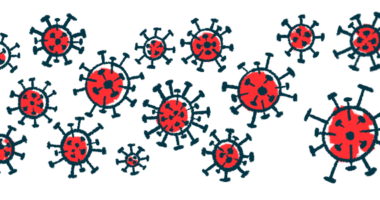COVID-19 May Trigger Acquired Hemophilia A, Case Study Says

bixstock/Shutterstock
SARS-CoV-2, the virus that causes COVID-19, might have triggered acquired hemophilia A (AHA) in a 65-year-old man with a clinical history of autoimmune thyroid disease, a U.S. case study reports.
This case suggests that COVID-19 infection should be considered when looking for potential causes of AHA.
The study, “Severe acquired haemophilia associated with asymptomatic SARS-CoV-2 infection,” was published in the journal BMJ Case Reports.
Acquired hemophilia A is a very rare condition characterized by bleeding in patients who have no personal or family history of blood clotting diseases. In this disorder, the immune system produces antibodies that target and destroy a blood clotting protein, called factor VIII (FVIII), ultimately resulting in excessive bleeding.
In about 17%–18% of cases, acquired hemophilia A is associated with other autoimmune disorders such as systemic lupus erythematosus or rheumatoid arthritis. Medications, pregnancy, and infections (particularly hepatitis C, HIV, tuberculosis, urinary tract infections, and influenza A) can also trigger the disease. However, in about half of the cases, its cause is unknown.
SARS-CoV-2 has been reported to induce autoimmune conditions, including autoimmune hemolytic anemia and Evan’s syndrome. However, until now, only three cases of SARS-Cov-2 infection associated with acquired hemophilia A have been reported in the literature.
In this new report, researchers in the U.S. described the case of a man whose acquired hemophilia A is suspected to have been caused by COVID-19.
The 65-year-old man arrived at the hospital with shortness of breath, chest pain, and extensive bruising in his arm. The patient had a clinical history of heart failure and chronic obstructive pulmonary disease (COPD). His thyroid had been surgically removed around 30 years ago to treat Hashimoto thyroiditis, an autoimmune disorder in which the body’s immune system produces antibodies that attack the thyroid gland.
Laboratory tests showed the patient’s blood was taking longer to clot than normal, suggesting the presence of a bleeding disorder. Moreover, his FVIII levels were low, and additional tests revealed the presence of FVIII inhibitors, or neutralizing antibodies against this blood clotting protein, in his bloodstream, consistent with a diagnosis of acquired hemophilia A.
A computed tomography scan of the chest, abdomen, and pelvis showed he had emphysema (a severe form of COPD), a very small nodule in the lungs, and signs of cirrhosis, or scarring, in the liver.
A SARS-CoV-2 PCR test was also performed and came back negative. However, a total SARS-CoV-2 antibody test was positive, confirming that he had been infected with the virus. Yet, he had no symptoms of COVID-19.
Doctors also found that he had an elevated level of thyroid stimulating hormone, but his free thyroxine level was normal. This was treated by adjusting his dose of levothyroxine, a medication used to replace a hormone normally produced by the thyroid gland.
Other blood tests were conducted to check for autoimmune disorders, cancer, and infections, but all were negative.
The patient underwent surgery to relieve the pressure and swelling on his arm. Due to complications and blood loss, however, he required massive blood transfusions.
To remove inhibitors from his bloodstream, he was started on intravenous methylprednisolone and then switched to an oral prednisone taper, accompanied by a four-week weekly regimen of rituximab and a five-day course of intravenous cyclophosphamide, which was then tapered to oral cyclophosphamide.
Although his FVIII levels improved, inhibitor levels remained high, prompting physicians to start him on FEIBA, an approved bypassing agent, given at a dose of 50 units per kilogram of body weight every other day until inhibitor levels reached zero and he no longer experienced active bleeding.
After receiving two doses of FEIBA and additional blood transfusions, the patient was eventually discharged to a rehabilitation facility with instructions to continue tapering off prednisone and cyclophosphamide.
Three weeks following discharge, he was free of spontaneous bleeds. His FVIII levels were also normal with a repeat inhibitor level of zero.
The study authors noted that they could not guarantee that SARS-CoV-2 was the absolute cause of acquired hemophilia A in the patient, since he did not have any COVID-19 symptoms. Yet, they explained it was possible “the patient suffered a previous SARS-CoV-2 infection prior to his current admission and this was perhaps the trigger for the production of factor inhibitor, especially with his underlying predisposition for autoimmunity given his history of autoimmune thyroiditis.”
“A case series of similar presentations, or a presentation of increasing incidence of acquired haemophilia A in current/post SARS-CoV-2 pandemic compared with prepandemic time would add strength to our theory of causation, but this will require more time and investigation to determine given the rarity of acquired haemophilia A,” they wrote.








